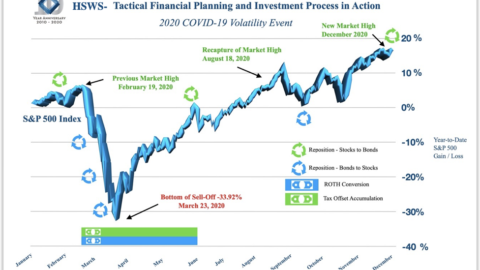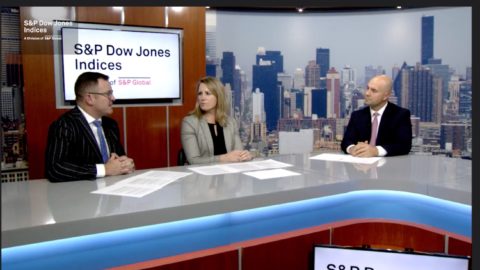Getting the Most Bang for your Buck:
Roth Conversion during a Market Pullback
By: Allison Schmidt, Financial Advisor, CFP®, CPA

There are several reasons to consider a Roth conversion no matter what the market is doing.
The most common time to consider a conversion is when your income is lower than it has been in the past or likely will be in the future: think retiring before social security/pensions begin or a pay-cut/furlough due to COVID-19. Another common reason to consider a Roth conversion is when you’re in a lower tax bracket than your heirs. These examples all have a common theme: pay tax when you’re in a lower tax bracket. These are strategies that we implement regularly for clients as a piece of long-term tax planning.
This year, in March, however, we were presented with an opportunity to tactically convert some of a Traditional IRA to a Roth IRA in response to the significant market pullback. My partner, Steve Higgins, and I put out a video briefly discussing the strategy, Tactical Financial Planning & Tax Management, but thought it was worth another blog post to cover a couple additional points specific to the market decline Roth conversion strategy.
Let’s start at square one…
A Roth conversion is simply moving dollars from a Traditional IRA (pre-tax) to a Roth IRA (post-tax). You will pay ordinary income tax in the year that the money moves. So if you’re in the 24% tax bracket and you convert $50k from a Traditional IRA to a Roth IRA you would have to pay $12k in federal tax (and additional state tax) on that conversion.
So you’re saying I have to pay tax?
Yes, you do, but you’re paying on your terms…does that make it a little more appealing? All situations are different, but we typically only recommend these types of conversions when you’re able to make the tax payments from non-IRA assets, so utilizing cash outside of retirement accounts so not to increase the withdrawals in a market decline to pay the tax.
There better be a benefit…
Oh there is, and the benefit is tax-free gains. The $50k that made its way to the Roth IRA now will potentially grow completely tax free. So if that amount grows from $50k to $75k, there is no additional tax due on the $25k in growth. This is especially helpful once you’re in retirement and we’re working on creating a tax-efficient income stream for you. If you have a combination of pre-tax (401k, IRA) and post-tax (Roth) assets, many times, we’re able to work with the current tax structure in an effort to create an income stream that manages the amount you’re paying in taxes.
What’s the deal with a market pullback…
When the market pulls back, as we saw in March, accounts decline (I bet you knew that). If we move the assets out of the Traditional IRA when the values are lower and tax them at the lower rate, you pay less in tax. We certainly don’t want to sell low, so it is imperative to keep those assets invested in the Roth to participate in the eventual bull market to follow.
Why it’s worth your time…
It comes down to the bull markets that immediately follow bear markets. According to a March 2020 report from Fidelity Investments, in the year after the “trough” of a bear market, the S&P 500 has gained an average of 47%. That is in comparison to the little over 8% per year on average that the S&P 500 has returned over the last 20 years*. To go back to my example of a $50k conversion, let’s assume you did that when the market was at the low on March 23rd of this year. The S&P 500 is up 44.54%* from March 23rd through yesterday, July 28th, so that $50k grew to just over $72k in about 4 months, $22k of tax-free growth.
Go on…
As always, everyone’s situation is different and despite the appealing numbers it does not always make sense in every situation, but I think we can all agree is worth considering. We haven’t had a market decline as quickly as we saw in March, and we hadn’t had as deep of a decline since the Great Financial Crisis of 2008-2009. Mix that with a health crisis, and we all were trying to figure out what was going to happen: to our loved ones, to our money, and to our lifestyles. The emotion and fear that those environments create can make levelheaded decisions incredibly difficult to make. When it comes to your money, we’ve found that having processes and plans in place before the heart pounding begins and emotions start to pervade is extremely important. There are beneficial (fleeting) opportunities during these bear market moments where wealth can be created.
Through our blog and our virtual meetings, we’ve been discussing concepts and strategies when the waters are calm so that we’re able to implement these strategies when we enter the next Bear market together.
Securities offered through LPL Financial, Member FINRA/SIPC. Investment advice offered through HD Wealth Strategies, a registered investment advisor and separate entity from LPL Financial. The opinions voiced in this material are for general information only and are not intended to provide specific advice or recommendations for any individual.
Traditional IRA account owners have considerations to make before performing a Roth IRA conversion. These primarily include income tax consequences on the converted amount in the year of conversion, withdrawal limitations from a Roth IRA, and income limitations for future contributions to a Roth IRA. In addition, if you are required to take a required minimum distribution (RMD) in the year you convert, you must do so before converting to a Roth IRA. This is a hypothetical example and is not representative of any specific situation. Your results will vary. The hypothetical rates of return used do not reflect the deduction of fees and charges inherent to investing.










